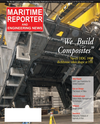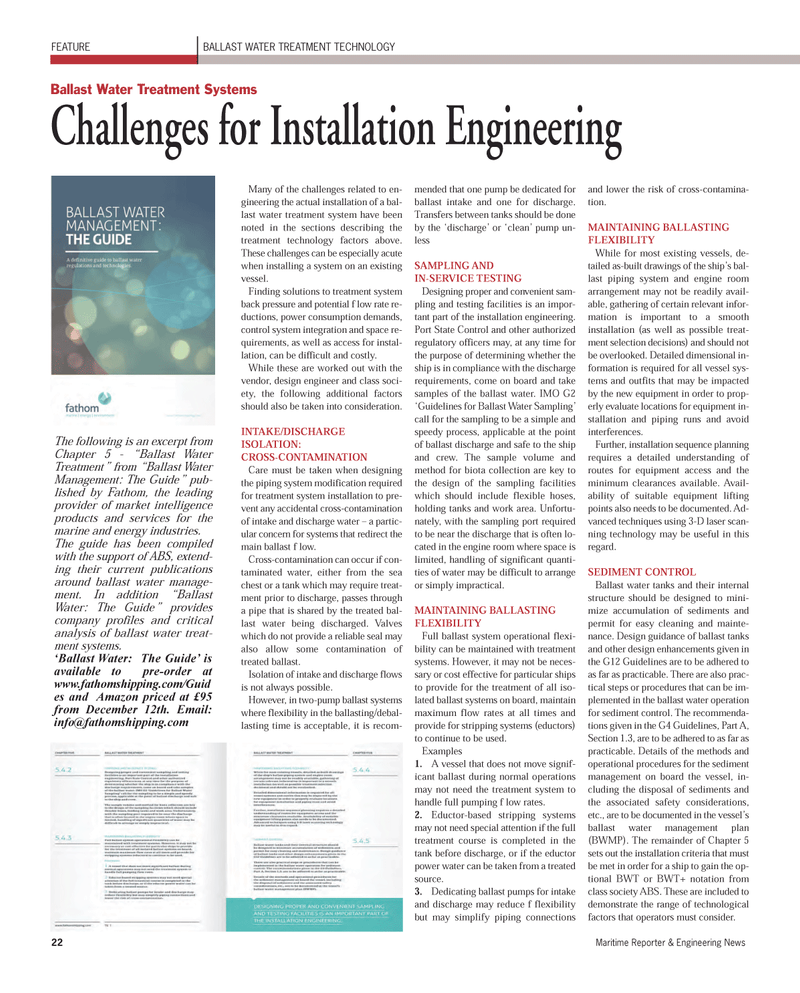
Page 22: of Maritime Reporter Magazine (January 2012)
US Navy Report
Read this page in Pdf, Flash or Html5 edition of January 2012 Maritime Reporter Magazine
22Maritime Reporter & Engineering News Many of the challenges related to en- gineering the actual installation of a bal-last water treatment system have been noted in the sections describing thetreatment technology factors above. These challenges can be especially acutewhen installing a system on an existing vessel. Finding solutions to treatment systemback pressure and potential f low rate re- ductions, power consumption demands, control system integration and space re- quirements, as well as access for instal-lation, can be difficult and costly. While these are worked out with the vendor, design engineer and class soci- ety, the following additional factors should also be taken into consideration. INTAKE/DISCHARGE ISOLATION: CROSS-CONTAMINATION Care must be taken when designing the piping system modification requiredfor treatment system installation to pre-vent any accidental cross-contamination of intake and discharge water ? a partic- ular concern for systems that redirect themain ballast f low. Cross-contamination can occur if con-taminated water, either from the sea chest or a tank which may require treat-ment prior to discharge, passes through a pipe that is shared by the treated bal-last water being discharged. Valves which do not provide a reliable seal may also allow some contamination of treated ballast.Isolation of intake and discharge flows is not always possible. However, in two-pump ballast systems where flexibility in the ballasting/debal- lasting time is acceptable, it is recom-mended that one pump be dedicated forballast intake and one for discharge. Transfers between tanks should be done by the ?discharge? or ?clean? pump un- lessSAMPLING AND IN-SERVICE TESTINGDesigning proper and convenient sam- pling and testing facilities is an impor- tant part of the installation engineering.Port State Control and other authorizedregulatory officers may, at any time for the purpose of determining whether theship is in compliance with the discharge requirements, come on board and take samples of the ballast water. IMO G2 ?Guidelines for Ballast Water Sampling? call for the sampling to be a simple andspeedy process, applicable at the pointof ballast discharge and safe to the ship and crew. The sample volume and method for biota collection are key to the design of the sampling facilities which should include flexible hoses, holding tanks and work area. Unfortu- nately, with the sampling port required to be near the discharge that is often lo- cated in the engine room where space islimited, handling of significant quanti- ties of water may be difficult to arrange or simply impractical.MAINTAINING BALLASTING FLEXIBILITYFull ballast system operational flexi- bility can be maintained with treatmentsystems. However, it may not be neces- sary or cost effective for particular ships to provide for the treatment of all iso- lated ballast systems on board, maintainmaximum flow rates at all times and provide for stripping systems (eductors) to continue to be used.Examples1.A vessel that does not move signif- icant ballast during normal operationsmay not need the treatment system tohandle full pumping f low rates. 2.Eductor-based stripping systems may not need special attention if the fulltreatment course is completed in thetank before discharge, or if the eductor power water can be taken from a treated source.3.Dedicating ballast pumps for intake and discharge may reduce f flexibility but may simplify piping connections and lower the risk of cross-contamina- tion.MAINTAINING BALLASTING FLEXIBILITYWhile for most existing vessels, de- tailed as-built drawings of the ship?s bal- last piping system and engine roomarrangement may not be readily avail- able, gathering of certain relevant infor- mation is important to a smoothinstallation (as well as possible treat-ment selection decisions) and should notbe overlooked. Detailed dimensional in- formation is required for all vessel sys- tems and outfits that may be impacted by the new equipment in order to prop- erly evaluate locations for equipment in- stallation and piping runs and avoid interferences.Further, installation sequence planning requires a detailed understanding ofroutes for equipment access and theminimum clearances available. Avail- ability of suitable equipment liftingpoints also needs to be documented. Ad- vanced techniques using 3-D laser scan- ning technology may be useful in thisregard. SEDIMENT CONTROL Ballast water tanks and their internal structure should be designed to mini-mize accumulation of sediments andpermit for easy cleaning and mainte-nance. Design guidance of ballast tanksand other design enhancements given in the G12 Guidelines are to be adhered toas far as practicable. There are also prac- tical steps or procedures that can be im-plemented in the ballast water operation for sediment control. The recommenda- tions given in the G4 Guidelines, Part A, Section 1.3, are to be adhered to as far as practicable. Details of the methods andoperational procedures for the sedimentmanagement on board the vessel, in- cluding the disposal of sediments andthe associated safety considerations,etc., are to be documented in the vessel?s ballast water management plan (BWMP). The remainder of Chapter 5 sets out the installation criteria that mustbe met in order for a ship to gain the op- tional BWT or BWT+ notation fromclass society ABS. These are included to demonstrate the range of technologicalfactors that operators must consider. FEATURE BALLAST WATER TREATMENT TECHNOLOGY Ballast Water Treatment Systems Challenges for Installation Engineering The following is an excerpt from Chapter 5 - ?Ballast Water Treatment? from ?Ballast Water Management: The Guide? pub- lished by Fathom, the leading provider of market intelligence products and services for the marine and energy industries. The guide has been compiledwith the support of ABS, extend- ing their current publications around ballast water manage- ment. In addition ?BallastWater: The Guide? provides company profiles and critical analysis of ballast water treat- ment systems.?Ballast Water: The Guide? is available to pre-order atwww.fathomshipping.com/Guid es and Amazon priced at £95 from December 12th. Email:[email protected] MR Jan.12 # 3 (18-25):MR Template 1/9/2012 11:57 AM Page 22

 21
21

 23
23
